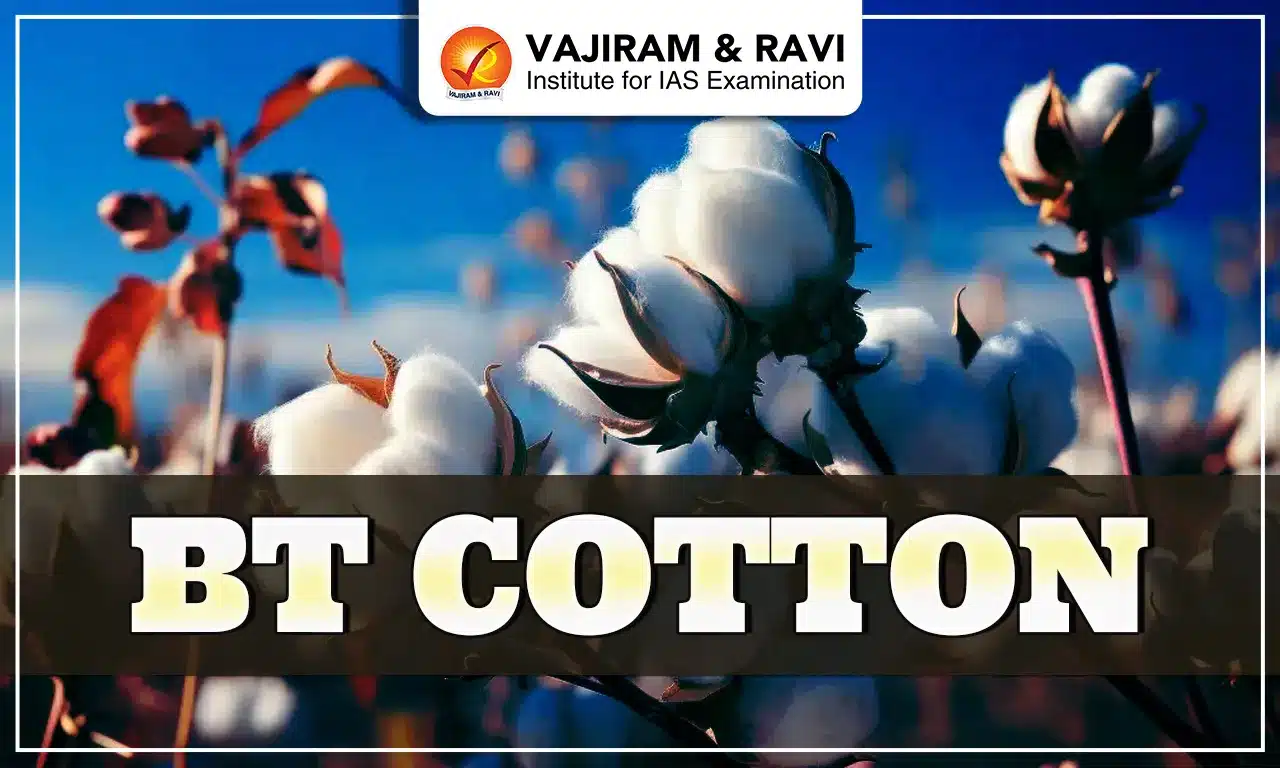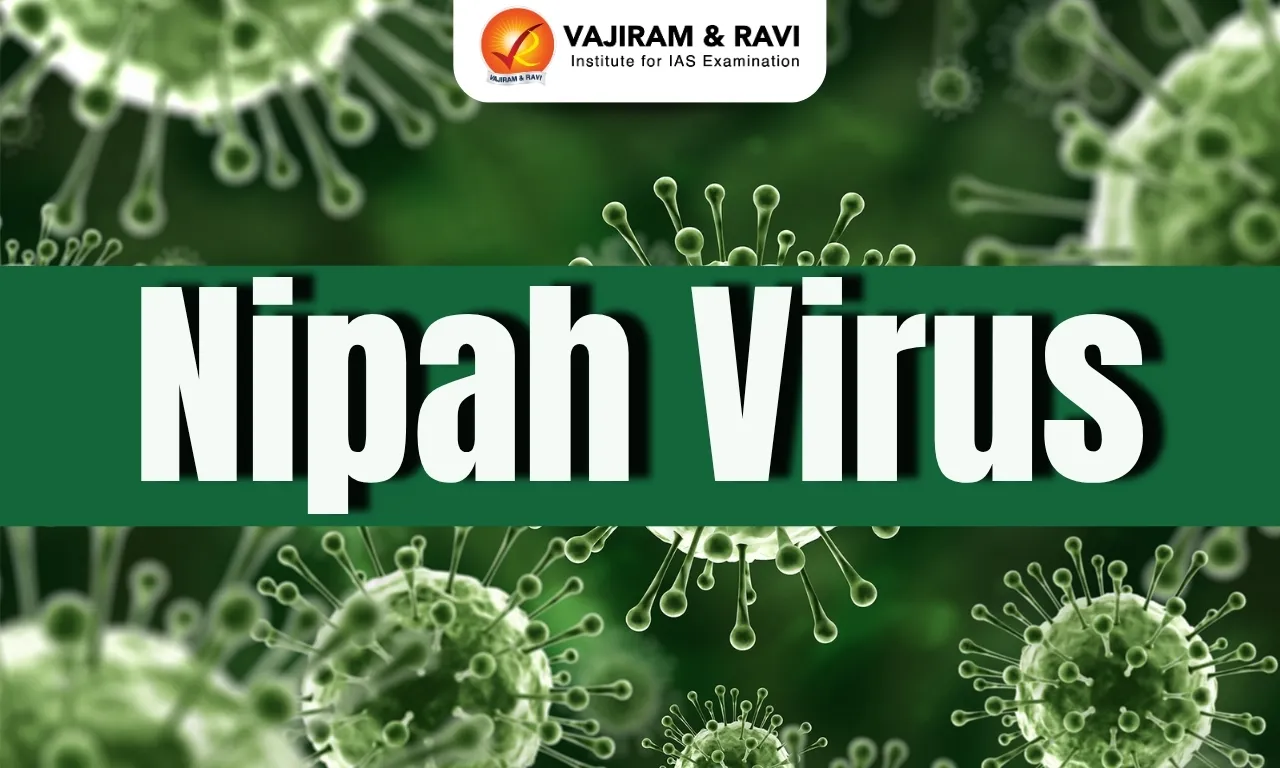Bt cotton is a genetically modified (GM) cotton crop that expresses an insecticidal protein whose gene was derived from the soil bacterium Bacillus thuringiensis, also known as Bt.
Many B. thuringiensis subspecies are found in soils and are generally known to be toxic to various insect genera but not to other living organisms. Bt. has been used as an insecticide to control stored grain pests in many other countries, including India, as sprays in cotton Integrated Pest Management (IPM) programs to control insects. Bt cotton was the first GM cropapproved in India in March 2002 for commercial cultivation.
Development of Bt Cotton
Bacillus thuringiensis was discovered in 1901 by a Japanese biologist, Shigetane Ishiwatari.
Bt cotton has been genetically modified (GM) by inserting one or more genes from Bacillus thuringiensis, (a common soil bacterium) making them transgenic plants.
- The insertion of B. thuringiensis genes causes cotton plant cells to produce crystal insecticidal proteins known as Cryproteins.
- These insecticidal proteins are effective in killing some of the most damaging cotton caterpillar pests, such as tobacco budworm and bollworm larvae.
- Bollgard I: In 1996, Bollgard cotton (a trademark of Monsanto) was the first Bt cotton to be marketed in the United States. The original Bollgard cotton produces a toxin called Cry 1Ac, which has excellent activity against tobacco budworms and pink bollworm.
- Bollgard II: It was introduced in 2003, representing the next generation of Bt cotton. It contains a second gene from the Bt bacteria which encodes the production of Cry 2Ab.
Features of Bt Cotton
Some features of Bt cotton include:
- Reduce Pesticide Use: Reduced pesticide use leads to:
- reduced the risk of poisoning people who apply pesticides or work in the fields and animals.
- Lower costs since fewer pesticide applications may be needed.
- Increased yield: Bt cotton has increased yields through better pest control and has benefited adopting farmers in India and several other developing countries.
- Improved Integrated Pest Management (IPM): The introduction of Bt cotton has enabled cotton farms to implement improved Integrated Pest Management (IPM).
- To further reduce pesticide use, IPM strategies employ a combination of natural controls and pest-specific chemistry.
- Soil health: Bt cotton showed no ill effects on soil invertebrates. Based on their morphological features, oviposition, fecundity rate, etc., the soil invertebrates are not affected by growing Bt cotton. Studies conducted by ICAR also did notshow any adverse effects on soil, microflora, and animal health.
- Environmental Protection: Bt cotton cultivars exhibited excellent control of Helicoverpa zea and Heliothis virescens (insect pests) and reduced the impact of insecticides to create an eco-friendly environment without compromising yield.
- Biosafety tests and assessment of toxicity to non-target organisms: Biosafety tests indicated absolute safety to goats, cows, buffaloes, fish, and poultry.
- The results of feed-safety studies revealed that animals fed Bt-cotton seed meal performed similarly to control animals in various tests and showed no adverse effects.
India and Bt Cotton
Cotton, also known as White Gold, is an important cash crop in India and plays an important role in the Indian economy. It supports more than 60 million people through agriculture, processing, and textile use. Cotton accounts for roughly two-thirds of total textile fiber consumption in India. The government is supporting the cotton farmers by procuring cotton under the Minimum Support Price (MSP).
- The major efforts to harness genetic engineering technology for bollworm resistance in cotton began in the 1990s in India with the import of GM cotton and the initiation of research programmes in national laboratories.
- Institutions: Bt cotton is the only GM crop approved for commercial cultivation in the country by the Genetic Engineering Appraisal Committee (GEAC) in 2002.
- In India, the regulation of genetically modified organisms involves the collaboration of two crucial ministries: the Department of Biotechnology, which operates under the purview of the Ministry of Science and Technology, and the Ministry of Environment and Forest.
- Production of Bt Cotton: As the share of Bt hybrids in the country’s area sown under cotton touched 95%, average per-hectare lint yields more than doubled from 278 kg in 2000-01 to 566 kg in 2013-14.
- But both production and yields started falling after 2013-14, to 343.5 lakh bales and 447 kg/hectare in 2022-23. This is due to pink bollworm larvae developing resistance to Bt proteins over time by continuously feeding on Bt hybrids.
Benefits of Bt Cotton in India
- Employment: The use of Bt cotton in India has resulted in massive increases in women's employment.
- Increase in farmer's income: The introduction of Bt cotton has brought impressive increases in the incomes of farmers as well as profits to biotechnology companies and seed companies.
- The impact of Bt cotton on Indian agriculture can be seen through the replacement of large tracts of varietal areas of north, west, and south India with Bt hybrids.
- These hybrids are instrumental in reducing the overall quantity of insecticides, apart from showing spectacular yield levels for cotton crops.
Limitation of Bt Cotton in India
- Non-resistant to other pests: Bt cotton was developed for cold-climate countries such as the United States, where pests are limited, most notably the bollworm, against which the Bt toxin works, and pest loads in fields are low.
- Apart from the bollworm, India has a plethora of cotton pests. Hence, pesticides will have to be used again because spraying is required to kill these other pests.
- Incompatibility with agricultural and climatic conditions: According to some experts, Bt cotton is unlikely to last more than a few years in India because it is fundamentally incompatible with the country's agricultural and climatic conditions.
- Insects are likely to develop resistance quickly, leaving the variety ineffective in a matter of years.
Herbicide-Tolerant (HT) Bt cotton
The HTBt cotton variant adds another layer of modification to Bt cotton, making the plant resistant to the herbicide glyphosate by introducing another gene Cp4-Epsps’ from another soil bacterium, Agrobacterium tumefaciens, but it has not been approved by regulators in India.
- Bacillus Thuringiensis is resistant to the attack of pink bollworms but is unable to stand the application of glyphosate.
- Concerns: There is a big increase in such illegal cultivation in India. According to the Federation of Seed Industry of India (FSSI), the HTBt cotton area will be around 15% of the total cotton area in India.
- Concerns include glyphosate being carcinogenic as well as the unchecked spread of herbicide resistance to nearby plants via pollination, resulting in a slew of superweeds.
- Illegal cotton seed sales using prominent company brands pose risks to farmers due to lack of seed quality, which also leads to environmental pollution.
- The industry loses legitimate seed sales, while the government also loses revenue in terms of tax collection.
Last updated on January, 2026
→ Check out the latest UPSC Syllabus 2026 here.
→ Join Vajiram & Ravi’s Interview Guidance Programme for expert help to crack your final UPSC stage.
→ UPSC Mains Result 2025 is now out.
→ UPSC Notification 2026 Postponed for CSE & IFS which was scheduled to be released on 14 January 2026.
→ UPSC Calendar 2026 has been released.
→ UPSC Prelims 2026 will be conducted on 24th May, 2026 & UPSC Mains 2026 will be conducted on 21st August 2026.
→ The UPSC Selection Process is of 3 stages-Prelims, Mains and Interview.
→ Prepare effectively with Vajiram & Ravi’s UPSC Prelims Test Series 2026 featuring full-length mock tests, detailed solutions, and performance analysis.
→ Enroll in Vajiram & Ravi’s UPSC Mains Test Series 2026 for structured answer writing practice, expert evaluation, and exam-oriented feedback.
→ Join Vajiram & Ravi’s Best UPSC Mentorship Program for personalized guidance, strategy planning, and one-to-one support from experienced mentors.
→ UPSC Result 2024 is released with latest UPSC Marksheet 2024. Check Now!
→ UPSC Toppers List 2024 is released now. Shakti Dubey is UPSC AIR 1 2024 Topper.
→ Also check Best UPSC Coaching in India
Bt Cotton FAQs
Q1. What is Bt Cotton?+
Q2. What is the benefit of Bt cotton?+
Q3. What are the advantages of Bt cotton?+
Q4. Who discovered Bt?+




















